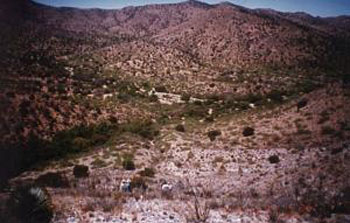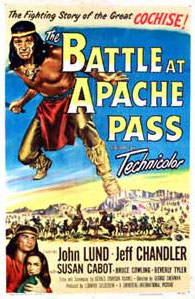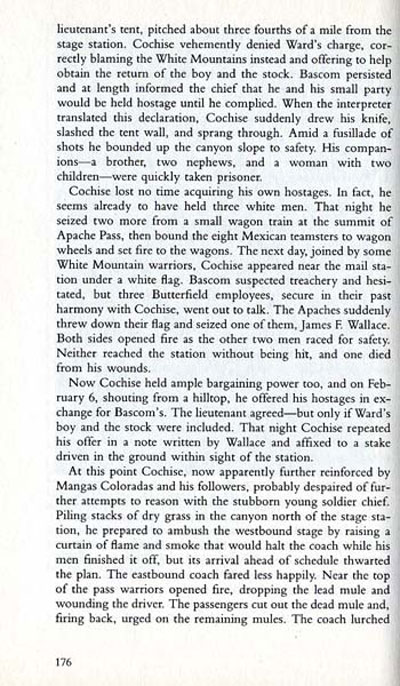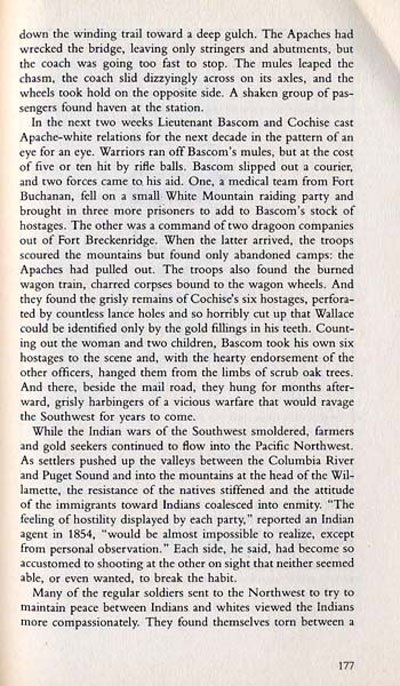
Located in forbidding Apache Pass, a landmark on the Overland Stage road, Fort Bowie played a significant role in the wars with the Chiracahua Apaches. Here in February 1861, even before the fort was established, Lt. George Bascom faced Cochise in a dramatic confrontation that touched off a quarter-century of bloody hostilities between the Chiricahuas and white invaders, and a personal ten-year war between Cochise and the U.S. Army.

General James H. Carleton, leading a Federal army eastward in 1862 to head off the Confederate invasion of New Mexico, founded Fort Bowie, and fought for two days, July 15 and 16, a battle with the Apaches for control of the nearby Apache Springs. Thereafter, until the final surrender of Geronimo, the post operated as a base for scouts, patrols, and major offensives against the Apaches. Most notably, Fort Bowie served as headquarters of Gen. George Crook and his successor Nelson A. Miles in the campaigns deep into Mexico that brought about the surrender of Geronimo and his band. From the Fort Bowie parade grounds in September 1886, Geronimo and his people started on their journey to Florida and imprisonment. The site is operated by the National Park Service.
Gregory F. Michno describes in his book, Encyclopedia of Indian Wars, the 1862 battle at Apache Pass.
After the Confederate invasion of New Mexico, Union Brig. Gen. James H. Carleton marched his brigade of 1,800 California soldiers east to catch the Rebels on the Rio Grande. As the advance guard-126 men of the 1st California Infantry, a detachment of cavalry under Capt. Thomas Roberts, 2 howitzers, and 22 wagons-labored up the western approach to the springs at Apache Pass, between the Chiricahua and Dos Cabezas Mountains, several hundred Apache warriors waited.
Near the springs, the warriors opened fire on the troops from the rocks above. Unable to reach their assailants, the soldiers had no choice but to blast the Indians out of the rocks. Roberts opened up with his two howitzers. Faced with exploding shells and flying rock fragments, the Indians fell back, and Roberts secured the springs.
Roberts sent six horsemen back to Capt. John C. Cremony, who waited at Dragoon Springs with the rest of the cavalry and the supply wagons. On the way, the horsemen ran into more Apaches. One of the soldiers, Pvt. John Teal, lagged behind, and the Indians cut him off from the others and shot his horse. Laying down beside his dying animal, Teal resolved to take at least one Apache with him. With a breech-loader and a pistol, he kept up a steady fusillade, preventing the Indians from rushing him. Teal shot one tall Apache in the chest, and it caused much commotion-the Indians took the warrior away and soon disappeared completely. Teal did not know it, but he had desperately wounded the great Apache leader Mangas Coloradas. The soldier picked up his saddle, bridle, and blanket and walked eight miles to Dragoon Springs, meeting Cremony just before he set out for Apache Pass.
When they arrived at the pass the next morning, Cremony and his men found the Apaches had reoccupied the cliffs. Once again, the artillery blasted them, clearing the path to the springs. The soldiers filled their canteens and departed on 17 July.
The two-day battle cost Roberts and Cremony two men; two others were wounded. Some of the men reported more than 60 Indians killed, but, more realistically, Roberts estimated 9 slain and perhaps 12 wounded.
The following is from the book, Indian Wars by Robert M. Utley and Wilcomb E. Washburn.


|